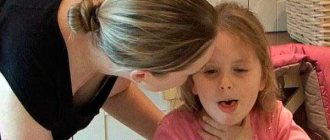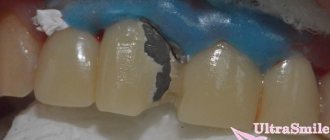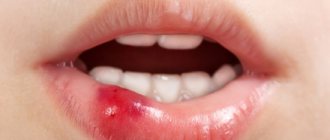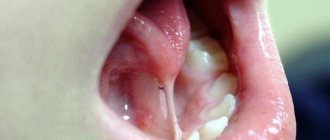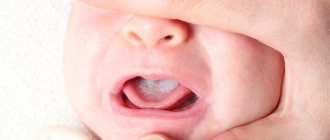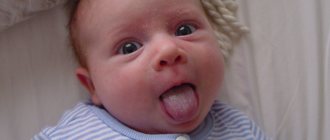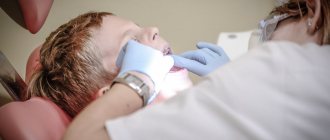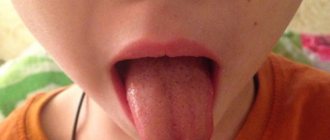In their practice, speech therapists most often encounter relatively mild forms of dysarthria. Otherwise they are called the erased form or dysarthric component. If severe degrees of dysarthria are easy to diagnose, then erased forms of the disorder can only be recognized by an experienced speech therapist or neurologist.
Many children with dysarthria may have been attending speech therapy groups for some time by the time the diagnosis is made, but without any results. Some children were observed by a neurologist in early childhood (1-2 years), but were removed from the register when visible improvements occurred.
Dysarthria is dangerous because it seriously inhibits the child’s speech development, since connections between the speech centers of the cerebral cortex and the articulatory apparatus are lost. The entire pronunciation aspect of speech is disrupted. The child speaks, but since he pronounces all sounds indistinctly, it is difficult to understand him. If correction is not started in time, then at school the child will begin to have serious problems with mastering written speech - dyslexia and dysgraphia.
How to tell if your baby is choking
There are many obvious signs that indicate your child is choking or choking. This process is divided into two stages: light and heavy.
Symptoms of the mild stage:
- the child is conscious;
- cough;
- vomit;
- cry;
- no breathing stops.
If the baby can cry, then his airways are clear. Vomiting often occurs due to intense coughing. Coughing and vomiting will clear the lungs and expel food particles. You should not slap the child on the back too much, because the body has already turned on its defense mechanisms. You can't turn it upside down, it will only hurt. You need to sit next to the child while he clears his throat and calm him down.
If the baby has a severe stage, then he will need serious treatment. Without emergency help, minutes count: a child may suffocate and die.
Signs of a severe stage:
- labored breathing;
- loss of consciousness;
- the child opens his mouth, but cannot make a sound;
- frightened eyes wide open;
- the baby holds his throat with his hands;
- salivation;
- blue skin.
You need to call an ambulance immediately. You should not take any action on your own, especially if the baby choked not on food, but on some hard object. A foreign body from the respiratory tract can only be removed by an experienced, qualified doctor.
When should you contact specialists?
Typically, a dysarthric child sees a speech therapist at 4-5 years of age. This is quite late, but with proper correction and regular classes, the violation can be minimized by the time he enters first grade. The sooner you contact specialists, the higher the chances of success.
A simple test will help determine whether a child has problems with the mobility of the speech apparatus. Stand in front of the mirror, complete the tasks yourself first, then ask your child to repeat them:
- smile, and then stretch out your lips. Only the lips work, the teeth are closed, the chin does not move;
- stick out your tongue and then remove it;
- open your mouth slightly and spread your tongue on your lower lip, hold it in this position for 5 seconds;
- open and close your mouth wide, slapping your lips;
- open and close your mouth, make a tube with your lips, repeat several times;
- open your mouth, touch the corners of your mouth with the tip, move your tongue back and forth, imitating the pendulum of a clock.
Keep in mind that any conclusions can be drawn only after the child has made several unsuccessful attempts, because the first time he may not understand what is required of him. The following signs are reasons to contact a neurologist or speech therapist:
- the child cannot immediately find the right position for the speech organs;
- has difficulty holding them in a given position;
- the smile and protruding tongue seem to move to the side;
- he cannot perform individual movements;
- involuntary synchronous movements of the speech organs.
Dysarthria is also indicated by undeveloped fine motor skills, awkwardness, difficulty maintaining balance, excessive tension or relaxation of the muscles of the face and neck, and nasal pronunciation. If you notice at least two or three of the listed signs, immediately show your baby to a speech therapist and neurologist.
What not to do
Cases when a child chokes or chokes on food occur quite often. When a baby is teething, he can bite off a fairly large piece of food. If he cries or laughs at this second, he may choke. While exploring the world around them, children put everything into their mouths, and not always edible objects.
The most important thing parents should do is remain calm. The mother's fear is instantly transmitted to the child. If he gets scared, his condition will worsen.
If your baby coughs, it means he doesn’t need help. He can clear his throat on his own. It is enough to be nearby and comfort.
But if an object gets into the respiratory tract, then under no circumstances should you forcefully slap the child on the back if the child is standing or sitting. Because of this, the piece may fall even deeper. You need to lay the baby down so that the head and back are tilted. You cannot remove the item yourself; immediate medical attention is required. It is necessary to provide first aid to the baby using a special method.
For patients: A child has swallowed a foreign object: what is the danger and what to do?
Full text of the article:
This applies to children of ABSOLUTELY ANY AGE.
We are accustomed to thinking that swallowing coins and buttons is an age-related feature of babies who crawl on the floor and collect forgotten small things. In fact, my fifteen years of practical experience suggests that children of any age can swallow a foreign object: kindergarteners, primary schoolchildren, even teenagers who have the habit of chewing on a pen or putting a hair tie in their mouth to free up their hands. Then there is the question of technique: sudden laughter, fright, someone pushed, touched - and now the small object is already swallowed.
Question #1: Swallowed or Inhaled?
A small foreign object from a child's mouth can enter either the esophagus or the respiratory tract. Both are quite dangerous, but in the case of inhalation, you need to act as quickly as possible, as there is a risk of asphyxia (suffocation).
Foreign object in the respiratory tract
Scenario one, the most alarming: the child is suffocating
If a child suddenly begins to cough hoarsely, possibly with wheezing, his breathing gradually weakens, the skin on his face turns blue - you need to urgently call an ambulance and provide the child with first aid. If you are not sure that you know exactly how to act, it is better to ask the ambulance dispatcher for help: you will be given detailed instructions on how to help the swallowed object jump out of the respiratory tract or at least move so that the child can breathe.
Scenario two: the child has inhaled an object, but does not choke
If a child, having inhaled a foreign object, coughs and feels well, this does not mean that the danger has passed: the foreign body remains in the respiratory tract, it can move and block the air, scratch soft tissues, and cause an inflammatory process. Therefore, the best thing you can do is either call an ambulance or go to the hospital yourself and seek help from a doctor.
In Moscow, two medical organizations provide 24-hour assistance to children who have swallowed foreign objects:
- endoscopy department at the Morozov hospital;
- on-duty endoscopic service at the Research Institute of Emergency Pediatric Surgery and Traumatology.
Scenario three: everything is unclear
Either he inhaled it, or he absorbed it, or it rolled behind the closet... The child is not sure of anything, and you are even more so. Then the simplest and wisest decision is to come to the nearest emergency room and get a chest x-ray. It almost always shows the presence of a foreign body in the airway, and then, most likely, you will be referred to an endoscopist who can do a bronchoscopy and remove the stuck object.
Scenario four, mysterious: they didn’t tell you anything
There are often situations when a child simply does not attach any importance to the fact that something got into his throat and then stopped bothering him. It happens that children, out of fear, keep silent about the fact that they inhaled something: maybe it will blow through, no one will scold. In this case, the foreign object does not disappear anywhere and can from time to time “reward” the child with unpleasant consequences, such as:
- Difficulty breathing, sudden bouts of coughing;
- Frequent bronchitis, chronic inflammatory process in the respiratory tract.
If you notice such symptoms in your children, and doctors doubt the diagnosis, this is a reason to do a bronchoscopy. During the study, forgotten objects that ended up in the respiratory tract weeks and months, and sometimes years ago are often discovered in the bronchi and lungs of children.
Foreign object in the gastrointestinal tract
The most important thing here is what exactly was swallowed. It is not good to swallow any objects, but there are some that can cause serious harm to a child’s health literally within a few hours.
Top 5 most dangerous swallowed objects:
- Battery
. Any size and filling, charged or discharged, a battery can get stuck in the esophagus, cause electrical injury or burn the mucous membrane due to leakage of electrolyte, in fact, this threatens perforation and ultimately can even lead to death. Conclusion: if there is a suspicion that a child has swallowed a battery, you need to urgently go to the doctor.
- Magnets
. It is especially dangerous if several small magnets were swallowed with some difference in time - then there is a high probability that, once in the gastrointestinal tract, they will attract each other, damage the tissue and create an obstruction.
- Silica gel beads
. These materials tend to swell and cause obstruction. The so-called hydroballs, in which bouquets of flowers are placed, are especially dangerous.
- Piercing and cutting objects
. Nails, hairpins, pins, needles, paper clips and anything that can damage soft tissue. Objects of any size and diameter are dangerous: large ones can hurt more, but small ones are much more difficult to detect.
There are also items that leave a child’s intestines relatively easily: small coins, streamlined buttons, pieces of Lego, pen caps, beads, beads. If you wait a couple of days, the items will most likely come out on their own without causing significant harm to the child.
How to avoid? Tips for parents
If the child is small:
- Do not give your baby toys containing small parts;
- Make sure that all your child’s toys are intact: if a soft toy is torn, the filling may fall out of it; if there is a crack in the plastic parts, you can break off a piece and swallow it, etc.
- Remove or, as a last resort, wrap with tape all battery-powered items: remote controls, watches, electronic toys. This way the battery will not end up in the child’s hands.
- From an early age, try to explain why it is dangerous to put into your mouth and swallow small objects that are not intended for food.
If the child is over three years old:
- Make sure that the child does not develop the habit of turning small objects in his hands and putting small objects in his mouth, especially needles when sewing and hairpins when combing his hair;
- Explain why you shouldn’t suddenly scare your peers by attacking them from behind (they may have a foreign object in their mouth, and a piece of sandwich in such a situation can be very dangerous).
- Do not intimidate children, do not threaten punishment: let your child be ready in the event of an incident to come to you and tell you what exactly he swallowed. This way you will be warned, which means you can take action in a timely manner.
What to do if a newborn or an infant under 1 year is choking
Infants can often choke on their mother's milk. This happens for various reasons:
- Incorrect attachment of the baby to the breast - during feeding, the baby's head should be located above the legs and pelvis.
- Long breaks between feedings - a hungry baby sucks the breast (bottle) too quickly and forcefully. Without having time to swallow, he may choke.
- Too much milk in the breast - the milk flows too quickly, and the baby does not have time to swallow everything. The same thing happens if there is a very large hole in the nipple of the bottle.
It is necessary to learn how to properly attach a baby to the breast. If he chokes while feeding, you need to provide first aid:
- Raise both baby's arms up.
- Extend your hand and place the baby on it. The face should be in the mother's palm. The buttocks should be located above the head.
- You need to work with the lower part of the inside of your palm. It is necessary to gently push the child between the shoulder blades 5 times. Movements must be performed from top to bottom.
- Then turn the baby onto his back so that his buttocks remain above his head. You need to gently press under the ribs 5 times to push the milk out of the lungs.
- Alternate these two methods until the baby breathes on his own.
If a piece of food is stuck in the larynx, you can press your finger on the tip of the tongue to induce vomiting, or lift the baby by the legs, face down.
If the baby loses consciousness or begins to choke, then first aid must be provided until the ambulance arrives. All actions must be performed with force, but not harshly.
An infant whose diet has been introduced to complementary foods must be taught proper table manners (not laughing or talking with his mouth full).
Chewing or grinding of teeth in a child
Chewing or smacking in sleep is an uncontrolled contraction of the oral masticatory muscles, accompanied by a sharp clenching of the jaws, grinding of teeth, smacking, excessive salivation, creaking and other symptoms. In medicine, this problem is called “bruxism.”
The period of time during which a person chews can range from a few seconds to 5-10 minutes. Typically, during the entire sleep phase, several episodes of pathology can be noticed. If one episode lasts more than 15 seconds, cracks and chips in the teeth and soft tissue injuries may occur.
Experts have linked a variety of slurping sounds, chewing, and teeth grinding to other sleep disorders. They accompany somnambulism, snoring, urinary incontinence at night, and the occurrence of nightmares. The popular version attributes the symptoms of bruxism to infection with worms. However, in reality, night sounds of teeth and the presence of parasites in the body are in no way connected.
Most often, manifestations of bruxism, when a person periodically swallows saliva, grinds teeth, smacks or chews, are associated with psycho-emotional disorders, for example, depression, stress, mental overload. Excessively active activities before bedtime, overexcitation, growing internal anxiety, and general tension provoke restless sleep.
If the episodes last no more than 10 seconds and occur 1-2 times per night, then this may not indicate any disease, but simply be an individual feature.
This is especially true for young children, who are often subject to reflexes, and chewing at night is a kind of continuation of the sucking instinct or may indicate the child’s hunger.
First aid for a child over 1 year old
Children over 12 months old easily perceive the emotions of others, so they can be scared if their mother is afraid. You need to try to be calm and unperturbed. The baby can clear his throat on his own. If this does not happen, you need to lightly press the tip of your tongue to start vomiting.
If nothing helps, then you need to provide Heimlich first aid. There are two algorithms: for those who are conscious and for those who are unconscious.
If the baby is conscious and can stand or sit:
- Make a fist with your right hand and place your left hand on top of your right.
- Grasp him from behind and place your hands in the space between the navel and the baby's ribs.
- Bend your elbows and push the child into this area several times. These movements must be performed until the baby begins to breathe freely.
If the child is unconscious:
- Lay him on his back and sit on his hips. The baby's head lies flat and straight.
- Place your hands in the area between the ribs and lower abdomen. The right hand is in a fist, the left is on top of it. Both arms are bent.
- Make several quick upward thrusts towards the diaphragm. Continue until breathing is restored.
Henry Heimlich invented a very effective technique that saved many lives.
Treatment
Smacking in your sleep is not considered a pathology and does not threaten your health. Rather, this problem is not the sleeper himself, but his environment. There are several secrets that will help solve the problem of teeth movement and grinding:
- Try to organize your child’s activities in such a way that he does not experience too strong emotions, including positive ones. Protect him from stress, family quarrels, too active evening games, cartoons and computer games with a scary plot.
- If a child slurps regularly and often (more than 5-7 episodes per night), show him to specialists - a pediatrician, neurologist, somnologist. The cause of night grinding in adolescents may be vegetative-vascular disorders, which are accompanied by headaches and fluctuations in blood pressure.
- It is also necessary to exclude the viral load on the body and check for worms. If, in addition to manifestations of bruxism, the child is pale, inactive, has a disturbance in appetite and bowel movements, basic tests - urine and blood - will be required.
- Sometimes children chew because of an uncomfortable bed, scratchy bedding, stale dry air, or high temperature in the bedroom. Be sure to ventilate before going to bed, adjust the humidity to 50–70%.
- You can come up with evening rituals that will help your baby calm down faster. Swimming, listening to audio books, fairy tales, and some calm games, such as board games, are suitable.
If such symptoms are caused by a pathological condition or some disease, medications are selected only by a doctor. If a pathology is diagnosed, treatment will not be aimed at eliminating grinding or chewing, but at the root cause.
What to do if your child stops breathing
Sometimes stress or spasm of the larynx causes the baby to stop breathing. In this case, urgent assistance is needed.
- Lay him on his side.
- Slightly tilt his head back.
- Lift his chin.
If nothing helps, you need to call an ambulance and give the child artificial respiration:
- The child lies on his back with his head thrown back. The mouth should be slightly open. All foreign objects must be removed from the mouth.
- The parent takes two deep breaths into the child's mouth. If the baby's chest moves, it means he can breathe on his own. If not, resuscitation efforts must be continued.
- After 2 breaths, you need to do an indirect cardiac massage. You need to place your palms so that one is on top of the other. Place your hands on the baby's chest and make several strong pushing movements. The baby's chest should straighten after each blow. In total you need to make 15 clicks.
- If breathing and heartbeat have not returned, resuscitation continues. For 2 breaths there are 15 chest compressions.
These measures must be repeated until the ambulance arrives. The paramedic will take the baby to the hospital, where surgery will be performed to remove the foreign body.
How to help a child with dysarthria?
Dysarthric children with mild and moderate degrees of impairment, first of all, need regular classes with a speech therapist who knows the technique of speech therapy massage. You need to exercise at least three times a week. If you do not have the opportunity to visit a specialist, then at home you need to perform at least certain elements of speech therapy massage. In addition, the following are required:
- complex of articulatory gymnastics;
- games and exercises aimed at developing correct speech breathing (Strelnikova’s complex has proven itself well);
- finger games;
- massage to relax muscles and give them tone;
- development of fine motor skills - puzzles, mosaics, games with sand and water, modeling, drawing with colored rice, construction sets, exercises with the su-jok ring, etc.;
- general strengthening of the child’s health, in particular the nervous system.
Children with dysatria usually do well in exercises where they need to perform actions according to a model. If, for example, you are teaching a child to fasten buttons, first show it on a doll, then on yourself, then on the child’s clothes, guiding his every movement. Using the same principle, you will have to perform both articulatory gymnastics and breathing exercises: first you give the child a model, and then, under your guidance, he makes the movements independently.
